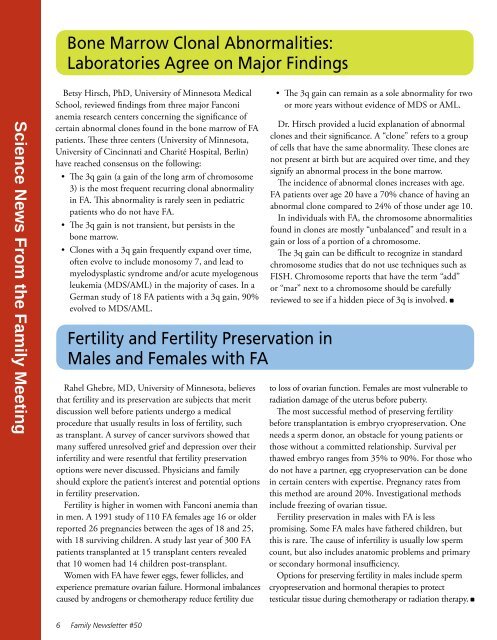FA Family Newsletter - Fanconi Anemia Research Fund
FA Family Newsletter - Fanconi Anemia Research Fund
FA Family Newsletter - Fanconi Anemia Research Fund
- No tags were found...
You also want an ePaper? Increase the reach of your titles
YUMPU automatically turns print PDFs into web optimized ePapers that Google loves.
Bone Marrow Clonal Abnormalities:Laboratories Agree on Major FindingsScience News From the <strong>Family</strong> MeetingBetsy Hirsch, PhD, University of Minnesota MedicalSchool, reviewed findings from three major <strong>Fanconi</strong>anemia research centers concerning the significance ofcertain abnormal clones found in the bone marrow of <strong>FA</strong>patients. These three centers (University of Minnesota,University of Cincinnati and Charité Hospital, Berlin)have reached consensus on the following:• The 3q gain (a gain of the long arm of chromosome3) is the most frequent recurring clonal abnormalityin <strong>FA</strong>. This abnormality is rarely seen in pediatricpatients who do not have <strong>FA</strong>.• The 3q gain is not transient, but persists in thebone marrow.• Clones with a 3q gain frequently expand over time,often evolve to include monosomy 7, and lead tomyelodysplastic syndrome and/or acute myelogenousleukemia (MDS/AML) in the majority of cases. In aGerman study of 18 <strong>FA</strong> patients with a 3q gain, 90%evolved to MDS/AML.Fertility and Fertility Preservation inMales and Females with <strong>FA</strong>Rahel Ghebre, MD, University of Minnesota, believesthat fertility and its preservation are subjects that meritdiscussion well before patients undergo a medicalprocedure that usually results in loss of fertility, suchas transplant. A survey of cancer survivors showed thatmany suffered unresolved grief and depression over theirinfertility and were resentful that fertility preservationoptions were never discussed. Physicians and familyshould explore the patient’s interest and potential optionsin fertility preservation.Fertility is higher in women with <strong>Fanconi</strong> anemia thanin men. A 1991 study of 110 <strong>FA</strong> females age 16 or olderreported 26 pregnancies between the ages of 18 and 25,with 18 surviving children. A study last year of 300 <strong>FA</strong>patients transplanted at 15 transplant centers revealedthat 10 women had 14 children post-transplant.Women with <strong>FA</strong> have fewer eggs, fewer follicles, andexperience premature ovarian failure. Hormonal imbalancescaused by androgens or chemotherapy reduce fertility due• The 3q gain can remain as a sole abnormality for twoor more years without evidence of MDS or AML.Dr. Hirsch provided a lucid explanation of abnormalclones and their significance. A “clone” refers to a groupof cells that have the same abnormality. These clones arenot present at birth but are acquired over time, and theysignify an abnormal process in the bone marrow.The incidence of abnormal clones increases with age.<strong>FA</strong> patients over age 20 have a 70% chance of having anabnormal clone compared to 24% of those under age 10.In individuals with <strong>FA</strong>, the chromosome abnormalitiesfound in clones are mostly “unbalanced” and result in again or loss of a portion of a chromosome.The 3q gain can be difficult to recognize in standardchromosome studies that do not use techniques such asFISH. Chromosome reports that have the term “add”or “mar” next to a chromosome should be carefullyreviewed to see if a hidden piece of 3q is involved.to loss of ovarian function. Females are most vulnerable toradiation damage of the uterus before puberty.The most successful method of preserving fertilitybefore transplantation is embryo cryopreservation. Oneneeds a sperm donor, an obstacle for young patients orthose without a committed relationship. Survival perthawed embryo ranges from 35% to 90%. For those whodo not have a partner, egg cryopreservation can be donein certain centers with expertise. Pregnancy rates fromthis method are around 20%. Investigational methodsinclude freezing of ovarian tissue.Fertility preservation in males with <strong>FA</strong> is lesspromising. Some <strong>FA</strong> males have fathered children, butthis is rare. The cause of infertility is usually low spermcount, but also includes anatomic problems and primaryor secondary hormonal insufficiency.Options for preserving fertility in males include spermcryopreservation and hormonal therapies to protecttesticular tissue during chemotherapy or radiation therapy.6 <strong>Family</strong> <strong>Newsletter</strong> #50
















